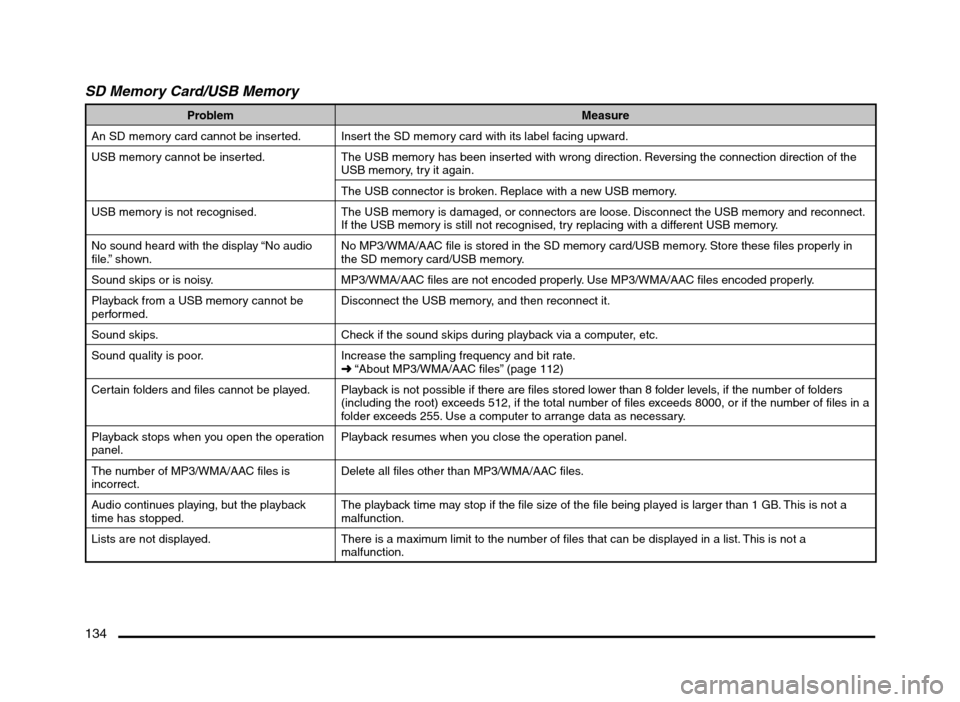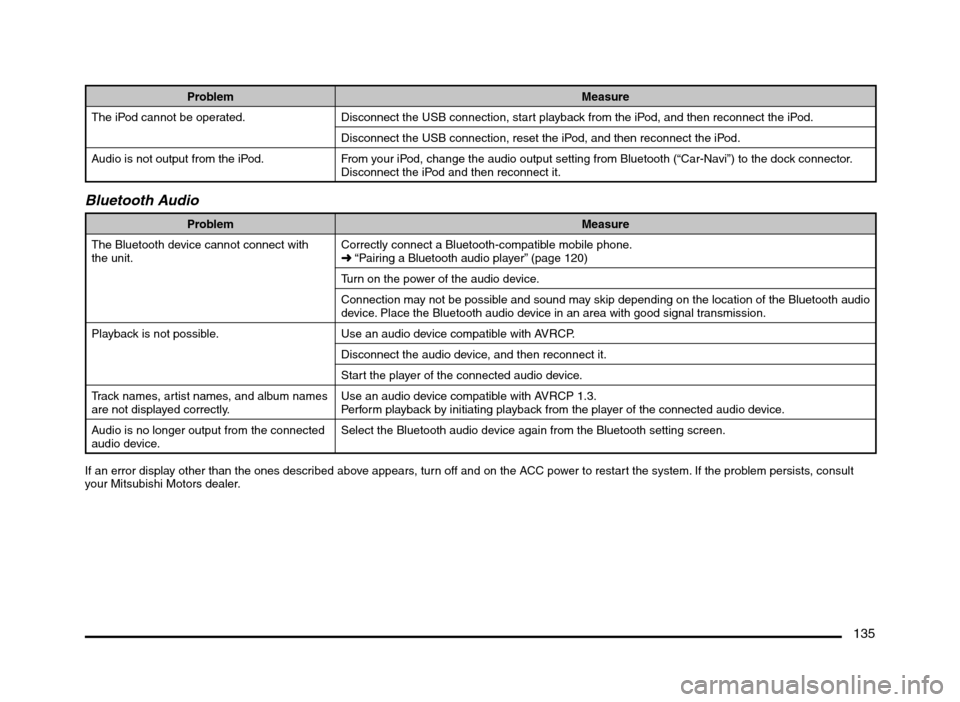display MITSUBISHI MIRAGE 2014 6.G MMCS Manual
[x] Cancel search | Manufacturer: MITSUBISHI, Model Year: 2014, Model line: MIRAGE, Model: MITSUBISHI MIRAGE 2014 6.GPages: 135, PDF Size: 26.9 MB
Page 134 of 135

134
SD Memory Card/USB Memory
Problem Measure
An SD memory card cannot be inserted. Insert the SD memory card with its label facing upward.
USB memory cannot be inserted. The USB memory has been inserted with wrong direction. Reversing the connection direction of the
USB memory, try it again.
The USB connector is broken. Replace with a new USB memory.
USB memory is not recognised. The USB memory is damaged, or connectors are loose. Disconnect the USB memory and reconnect.
If the USB memory is still not recognised, try replacing with a different USB memory.
No sound heard with the display “No audio
file.” shown.No MP3/WMA/AAC file is stored in the SD memory card/USB memory. Store these files properly in
the SD memory card/USB memory.
Sound skips or is noisy. MP3/WMA/AAC files are not encoded properly. Use MP3/WMA/AAC files encoded properly.
Playback from a USB memory cannot be
performed.Disconnect the USB memory, and then reconnect it.
Sound skips. Check if the sound skips during playback via a computer, etc.
Sound quality is poor. Increase the sampling frequency and bit rate.
É “About MP3/WMA/AAC files” (page 112)
Certain folders and files cannot be played. Playback is not possible if there are files stored lower than 8 folder levels, if the number of folders
(including the root) exceeds 512, if the total number of files exceeds 8000, or if the number of files in a
folder exceeds 255. Use a computer to arrange data as necessary.
Playback stops when you open the operation
panel.Playback resumes when you close the operation panel.
The number of MP3/WMA/AAC files is
incorrect.Delete all files other than MP3/WMA/AAC files.
Audio continues playing, but the playback
time has stopped.The playback time may stop if the file size of the file being played is larger than 1 GB. This is not a
malfunction.
Lists are not displayed. There is a maximum limit to the number of files that can be displayed in a list. This is not a
malfunction.
205-0010-00_QY-7375M-A_EN.indb 134205-0010-00_QY-7375M-A_EN.indb 1343/12/2013 9:57:30 AM3/12/2013 9:57:30 AM
Page 135 of 135

135
Problem Measure
The iPod cannot be operated. Disconnect the USB connection, start playback from the iPod, and then reconnect the iPod.
Disconnect the USB connection, reset the iPod, and then reconnect the iPod.
Audio is not output from the iPod. From your iPod, change the audio output setting from Bluetooth (“Car-Navi”) to the dock connector.
Disconnect the iPod and then reconnect it.
Bluetooth Audio
Problem Measure
The Bluetooth device cannot connect with
the unit.Correctly connect a Bluetooth-compatible mobile phone.
É “Pairing a Bluetooth audio player” (page 120)
Turn on the power of the audio device.
Connection may not be possible and sound may skip depending on the location of the Bluetooth audio
device. Place the Bluetooth audio device in an area with good signal transmission.
Playback is not possible. Use an audio device compatible with AVRCP.
Disconnect the audio device, and then reconnect it.
Start the player of the connected audio device.
Track names, artist names, and album names
are not displayed correctly.Use an audio device compatible with AVRCP 1.3.
Perform playback by initiating playback from the player of the connected audio device.
Audio is no longer output from the connected
audio device.Select the Bluetooth audio device again from the Bluetooth setting screen.
If an error display other than the ones described above appears, turn off and on the ACC power to restart the system. If the problem persists, consult
your Mitsubishi Motors dealer.
205-0010-00_QY-7375M-A_EN.indb 135205-0010-00_QY-7375M-A_EN.indb 1353/12/2013 9:57:30 AM3/12/2013 9:57:30 AM